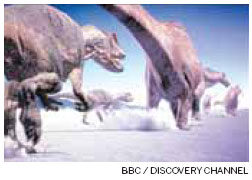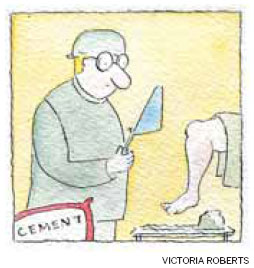Findings
Updated: 2013-06-16 07:42
(The New York Times)
|
|||||||

Dinosaur eating habits
Allosaurus, a smaller cousin of Tyrannosaurus rex, was a dexterous hunter that tugged at prey like a modern-day falcon, showing far more refined table manners than T. rex, researchers are reporting.
"While T. rex was like an angry gorilla with an ice pick, Allosaurus was like a surgeon with a scalpel," said Eric Snively, a mechanical engineer at Ohio University and an author of a new study on the smaller dinosaur based on 150-million-year-old bones. Using a CT scanner and a method called multibody dynamics, developed originally for robotics, the researchers modeled Allosaurus neck and jaw muscles and simulated its muscle movement.
"The skull is loaded with scars where muscles attach, and we were able to reconstruct the dinosaur by making comparisons to modern-day birds," said another author, Lawrence M. Witmer, a paleontologist at Ohio.
Though more than six meters long and twice as heavy as a polar bear, Allosaurus probably drove its teeth downward into its prey. Like such small falcons as the American kestrel, it held its head steady and then pulled flesh up; T. rex, by contrast, used more of a side-to-side thrashing action. SINDYA N. BHANOO

Artificial connections
For joint replacements, like a knee or hip, is muscle attached to the artificial implant?
Ordinarily "no muscle attaches to any hip or knee implant," said Dr. Mathias P. Bostrom of the Hospital for Special Surgery in Manhattan. The only human tissue that adheres to an implanted joint is bone.
The link is made either with cement or directly to the bone. When the connection is direct, the bone-producing cells grow new material that forms a bond with the implant.
"A lot of knee implants use a kind of cement, really more of a grout, that fixes to the bone itself," Dr. Bostrom said. "It is an acrylic, similar to Plexiglas, called PMMA, for polymethyl methacrylate."
In the case of a tumor prosthesis for a bone like the femur - in which a lot of bone is removed and large segments are replaced with metal - there may be some linkage of muscle and tendon to implant, he said.
In most joint implants, however, the muscle is still attached to the bone via the tendon, and the surgeon especially tries to avoid detaching any muscle insertion in the hip or knee.
"We want the tendon's attachment to the bone to be intact," Dr. Bostrom said. C. CLAIBORNE RAY
Keeping babies warm
In the United States, some very premature babies are swaddled in sterile plastic wrap to keep their body temperature from dropping dangerously. Now a study of newborns in Zambia suggests that the technique can be duplicated cheaply and effectively in poorer countries - using simple plastic bags.
"These are regular plastic bags, similar to grocery bags," said an author of the study, Dr. Waldemar A. Carlo, a specialist at the University of Alabama at Birmingham.
The skin of premature babies is very thin, and water evaporates quickly through it, sometimes leading to life-threatening heat loss, especially in a poor country where heat in neonatal wards can be unsteady.
In a hospital in Lusaka, Zambia, babies were placed on their mothers' chests right after birth in typical "kangaroo care," he said. But kangaroo care is not always enough to warm a child, and when babies were taken to be weighed or observed or because the mother fell asleep or needed medical treatment, putting them in a plastic bag before wrapping them in a blanket did a better job of keeping them warm than a blanket alone. DONALD G. McNEIL JR.
(China Daily 06/16/2013 page11)